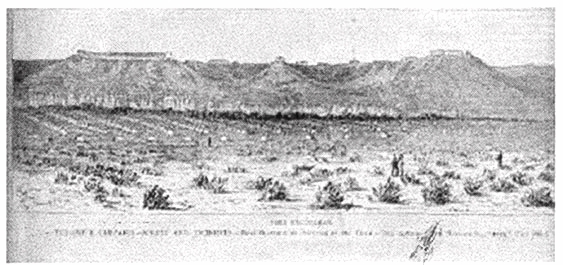
Distant view of Fort Fetterman, Leslie's Weekly News, 1876.
Fort Fetterman was established in 1867 high on the bluffs of the North Platte River, northwest of
present day Douglas.
B eing on the southside of the Platte, the fort was excluded from
the provisions of the Treaty of Fort Laramie which resulted in the abandonment of all
forts further to the north. It, thus, became the northernmost fort in eastern Wyoming.
the fort in its closing days was described by George Rex Buckman, Lippincott's Magazine, "Ranches and Rancheros of
the Far West," May 1882:
The quadrangle of low, dirt-roofed log cabins enclosing the parade-ground, the
officers' quarters, more pretentious with their little log piazzas, the house of the commanding
officer, for the construction of which the largest and straightest logs had been selected, and all nestled down
upon the bosom of the great outstretching plain, form a picture that will dwell long in the
mind of the beholder. Thus looked Fort Fetterman from the summit of the last ridge. Soon the
post is reached: the driver flourishes his whip, and with unwonted speed we are whirled up to the
post-office door, where we stop with a sudden jerk that sets the little-canvas-covered box swinging upon its leathern supports.
The soldiers stroll lazily out to look upon the one daily exitement while the travellers seek such refreshment as
can may be secured.
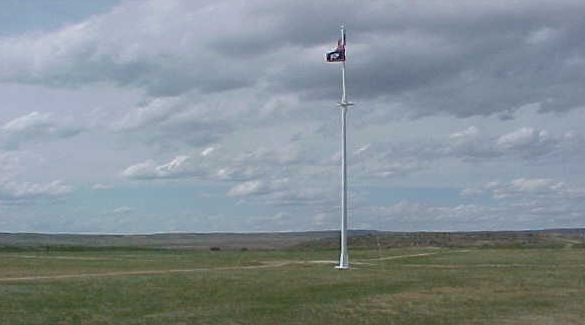
Fort Fetterman, Parade Ground, 2001, photo by Geoff Dobson
The Fort remained active until 1882 when it was abandoned by the Army.
The adjacent town of Fetterman City continued on for several more years until the Railroad reached
present day Douglas in 1886. Following the abandonment of Forts Reno and
Phil Kearney after the Treaty of Fort Laramie, Ft. Fetterman was the northernmost point on the telegraph line
to Ft. Laramie. During its brief existence the fort was always regarded as
hardship duty. One of the early commanders complained about the cold, the isolation, and the lack
of women. The latter complaint was partially resolved with the establishment of a hog ranch on the
north side of the river, the site of which is depicted in the next photo.
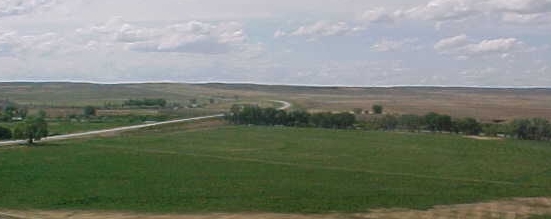
Site of Fort Fetterman Hog Ranch, 2001, photo by Geoff Dobson
The Hog Ranch was located on the north side of the Platte River beyond the trees and to the right of the road in the
above photo. A hog ranch was an establishment which combined the sins of gambling, booze, and
women of the night into one convenient location. Insofar as the troops at
Fort Fetterman were concerned it might not have been so convenient. As can
be seen in the above photo, it was on the opposite side of the river from the Fort. Soldiers
therefore had to swim across in order to enjoy its delights. Calamity Jane in her "autobiography" claims to
have swam the Platte River, not, however, to get to the Hog Ranch. She claimed that during General
Crook's campaign that she was stationed at Ft. Fetterman and had to swim the
river in order to deliver a dispatch to Gen. Crook. After delivery of the dispatch, she
alleges that she was returned to Ft. Fetterman in Crook's ambulance and recuperated for two weeks in the
post hospital. For further discussion of Calamity Jane see Deadwood Stage.
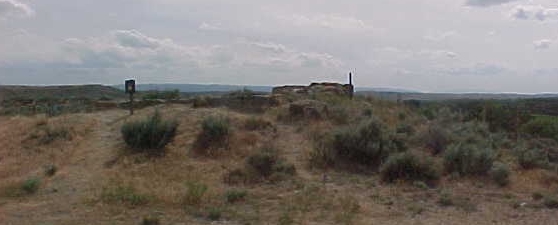
Ruins of Cistern, 2001, photo by Geoff Dobson
In addition to the cold and isolation, another difficulty with Fort Fetterman was lack of water.
Not withstanding that it was located adjacent to the North Platte River, the fort
was high on a bluff and water had to be carried by hand in buckets to the cistern. Eventually, however, as
depicted in the next photo, a pump was installed making life a little easier for enlisted men.
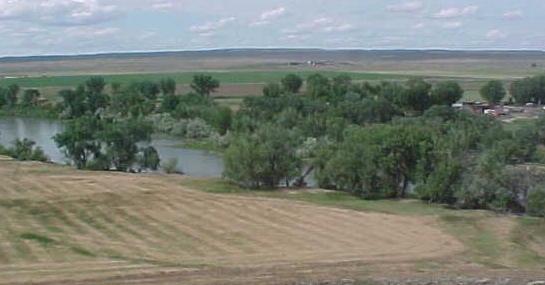
North Platte River, Ft. Fetterman, photo by Geoff Dobson
The pump to serve the fort was located near the clump of trees in the center of the photo.
As indicated above and on the next page, the adjacent town of Fetterman City continued on using some of the
fort's buildings until Doublas was established. One of the building which continued to be used was
the bachelor officers quarters, the site of which is depicted below.
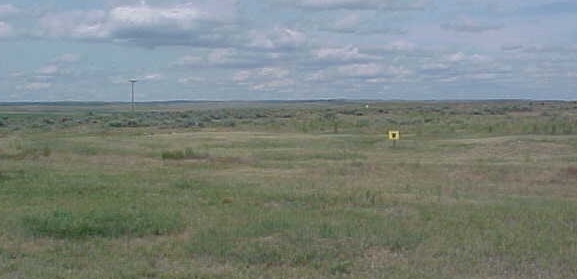
Site of Bachelor Officers Quarters, 2001, photo by Geoff Dobson
After the withdrawal of the military the bachelor officers quarters were used as the Hotel
Fetterman and the site was occupied by civilians. Owen Wister in his 1897 novel Lin McLean
described Fetterman City, referring to it as "Drybone":
"Drybone had known a wholesome adventurous youth, where manly lives and
deaths were plenty. It had been an army post. It had seen horse and foot,
and heard the trumpet. Brave wives had kept house for their captains upon
its bluffs. Winter and summer they had made the best of it. When the War
Department ordered the captains to catch Indians, the wives bade them
Godspeed. When the Interior Department ordered the captains to let the
Indians go again, still they made the best of it. You must not waste
Indians. Indians were a source of revenue to so many people in Washington
and elsewhere. But the process of catching Indians, armed with weapons
sold them by friends of the Interior Department, was not entirely
harmless. Therefore there came to be graves in the Drybone graveyard. The
pale weather-washed head-boards told all about it: "Sacred to the memory
of Private So-and-So, killed on the Dry Cheyenne, May 6, 1875." Or it
would be, "Mrs. So-and-So, found scalped on Sage Creek." But even the
financiers at Washington could not wholly preserve the Indian in
Drybone's neighborhood. As the cattle by ten thousands came treading with
the next step of civilization into this huge domain, the soldiers were
taken away. Some of them went West to fight more Indians in Idaho,
Oregon, or Arizona. The battles of the others being done, they went East
in better coffins to sleep where their mothers or their comrades wanted
them. Though wind and rain wrought changes upon the hill, the ready-made
graves and boxes which these soldiers left behind proved heirlooms as
serviceable in their way as were the tenements that the living had
bequeathed to Drybone. Into these empty barracks came to dwell and do
business every joy that made the cow-puncher's holiday, and every hunted
person who was baffling the sheriff. For the sheriff must stop outside
the line of Drybone, as shall presently be made clear.* The captain's
quarters were a saloon now; professional cards were going in the
adjutant's office night and day; and the commissary building made a good
dance-hall and hotel. Instead of guard-mounting, you would see a
horse-race on the parade-ground, and there was no provost-sergeant to
gather up the broken bottles and old boots. Heaps of these choked the
rusty fountain. In the tufts of yellow, ragged grass that dotted the
place plentifully were lodged many aces and queens and ten-spots, which
the Drybone wind had blown wide from the doors out of which they had been
thrown when a new pack was called for inside. Among the grass tufts would
lie visitors who had applied for beds too late at the dance-hall, frankly
sleeping their whiskey off in the morning air."
[*Writer's note: Until the federal government relinquishes jurisdiction to the
state or territory, local authorities have no authority within the confines of a
federal reservation.]

Distant View, Fort Fetterman, 1872. Photo by William Henry Jackson.
Certainly, there was not much exaggeration in Wister's description. In the first year following
the Army's withdrawal, there was one murder in the confines of Altman and Webel's Saloon and one extra-legal
hanging at the old guardhouse. At the conclusion of an 1882 round-up by the Goose Egg, the boys had
gathered in the saloon to spend their earnings. One cowboy, "Arkansas Red" Capps, was friendly when sober but
a beligerent drunk. Having already overdrawn and consumed his pay, he demanded from Dick Elgin, the
Goose Egg's popular bookkeeper and paymaster, another advance on his pay. When told that only the
owner, Mr. Searight could authorize another advance, Capps reached down for his revolver. The revolver was
triggerless. When he hit the holster it discharged grazing his hip. Apparently,
thinking that Elgin beat him on the draw, Capps pulled the revolver out and shot Elgin dead.
Capps fled the saloon and attempted to escape on Elgin's horse. Before Capps could reach the Platte, the horse threw
him. Malcolm Campbell, then a deputy sheriff, placed Capps in the old army guard house and assigned
Tom Walker to watch over the situation and make sure that Capps did not
escape. Campbell went back to his dinner. Soon Walker interrupted Campbell's dinner and advised that
Campbell could take his time with dinner. Walker had been "surprised" by some of Elgin's friends.
When Campbell arrived back at the guardhouse, he found Capps hanging from a log jutting out from the
corner of the log structure. The Goose Egg round-up crew gave a grand send-off for both Elgin and
Capps in the form of a glorious double funeral. The coroner's jury was unable to ascertain the names of those
who surprised Walker.
The incident was noted in John Hunton's Diary: "Dick Elgin killed at Fetterman yesterday. Murderer hung. Nice day."
The shooting was not the only one. Sir Samuel Baker in his Wild Beasts and Their Ways,
Macmillan and Co., London, 1890, described arriving at Fort Fetterman on his way to
visit Moreton Frewen:
* * * we alighted at the log-hut which represented the inn. The room was horridly dirty, the floor was sanded, and there was a
peculiar smell of bad drink, and an expression of depravity about the establishment.
The host was a tall man, attired as usual in a flannel shirt and trousers, with a belt a
and revolver. He had evidently observed an expression of disgust upon our faces, as he
exclaimed, "Well, I guess we ain't fixed up for ladies; and perhaps it's as well that you
came to-day instead of last night, if you ain't fond of shooting affairs. You were just looking
at that table and thinking the table-cover was a bit dirty, weren't you? Well, last night
Dick and Bill got to words over their cards, and before Dick could get out his six-shooter,
young Bill was too quick and resolute, and he put two bullets through him just across this
table, and he fell over it on his face, and never spoke a word. It's a good job too that Dick's got it at last."
This little incident was quite in harmony with the appearance of the den.
Fetterman City
is also noted as being the place where Malcolm Campbell captured Colorado's favorite
cannibal, Alferd Packer. Packer, photo below right, was living under the alias of John Swartz,
and was caught because a customer in a saloon, Jean "Frenchy" Cabazon who had known
Packer from Utah, recognized his laugh.
Packer survived a severe winter in the San Juans by dining on his
five companions. Upon his sentencing it is the popular legend that the judge told him:
"There were seven Demmycrats in Hinsdale County and you
ate five of them."
In actuality, the legend is untrue and probably finds its origin with a
report by Saquache saloon keeper Larry Dolan.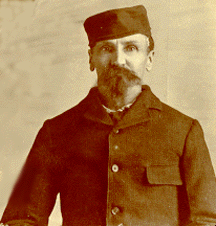 District Judge Melville B. Gerry,
although a Democrat, was a well respected jurist. The sentencing has been reported:
District Judge Melville B. Gerry,
although a Democrat, was a well respected jurist. The sentencing has been reported:
In 1872, you in the company with five companions, passed
through this beautiful mountain valley where stands the town of Lake City.
You and your victims had a weary march, and when the shadows of the
mountains fell upon your little party and the night drew her sable curtain
around you, your unsuspecting victims lay down on the ground and were soon
lost in the sleep of the weary; and then, thus sweetly unconscious of danger
from any quarter, and particularly from you, their trusted companion,
you cruelly and brutally slew them all. To other sickening details of your
crime I will not refer. I sentence you to be hanged by the neck until
you are dead, dead, dead, and may God have mercy on your soul.
Yet another version merely has the judge sentencing Packer, in conventional lanquage,
to be taken by the sheriff to a place in Lake City on a date specified and hanged.
Some debate exists as to Packer's correct first name, Alferd or Alfred. Packer usually signed
his name "A. G. Packer." Military and judicial records use "Alfred." Packer had a tatoo
using "Alferd." The
invitations to the scheduled hanging also used "Alferd." [Webmaster's comment:
Except when one is the guest of honor, how does one respond to an invitation to a
hanging? Is it R.S.V.P? Does one bring a gift or a going away present?]
The hanging was called off
when the conviction was reversed because the offense took place on an Indian
reservation and was, thus, not technically a violation of Colorado law. Packer was
subsequently convicted of manslaughter. Efforts by the Denver Post to have Packer
pardoned by Gov. Charles Thomas were unsuccessful. Governor Thomas later intimated that he
was in possession of correspondence from Packer that was so foul as not to be repeatable.
Even many years after Packer's death, Gov. Richard Lamm in 1979 refused a posthumous
pardon.
Today, as all Colorado Buffs fans are aware, Packer is honored by having the student eatery next to the
campus book store in the basement of the Student Service Center named the Alferd Packer Memorial Grille.
Colorado, however, may not necessarily have a monopoly on such matters. Eugene Ware in his 1911 work,
The Indian War of 1864, repeats a story told by an army scout, Leon
Palladie:
[T]he post commander up at Fort Benton, on the Missouri river,
heard that the Indians were plotting to destroy the frontier and had mapped
out among other things, a campaign against Fort Laramie. That was perhaps
about 1861 or 1862. The post commander of Fort Benton determined to send
a messenger across the country during the winter for the purpose of
notifying the commanding officers at Fort Laramie, because he thought
the latter post could not stand in the dead of winter a heavy siege
from the combined Indian nations. The mountaineer who was selected
to go wanted a companion; a half-breed Indian was sent with him. This
white courier was sent off with a letter which started out by saying:
"I send you Mr. So-and-so, accompanied by a halfbreed, So-and-so, to
convey you the following important information." The letter was presented
to Fort Laramie by the courier to the post commander, and he, after
reading the opening portion of it, said, "Where is your comrade?" and
the courier said, "I eat him." They had floundered through the snow and
the mountains, and the mountaineer had to eat the other man in order to
carry the message through in safety. Leo Palladie would tell this story,
and laugh and shriek every time he told it. It always seemed new and
interesting to him. I never could find anybody who ever heard the name
of the messenger that was sent, and I often used to think Palladie was
telling the story of one of his own personal experiences.
Palladie continued as a scout as late as the 1870's, serving with the 3rd Cavalry in 1872.
Fetterman City today, as indicated in the above photos, consists of a few foundations.
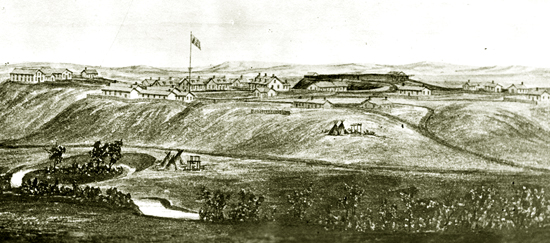
Fort Fetterman, 1870.
|